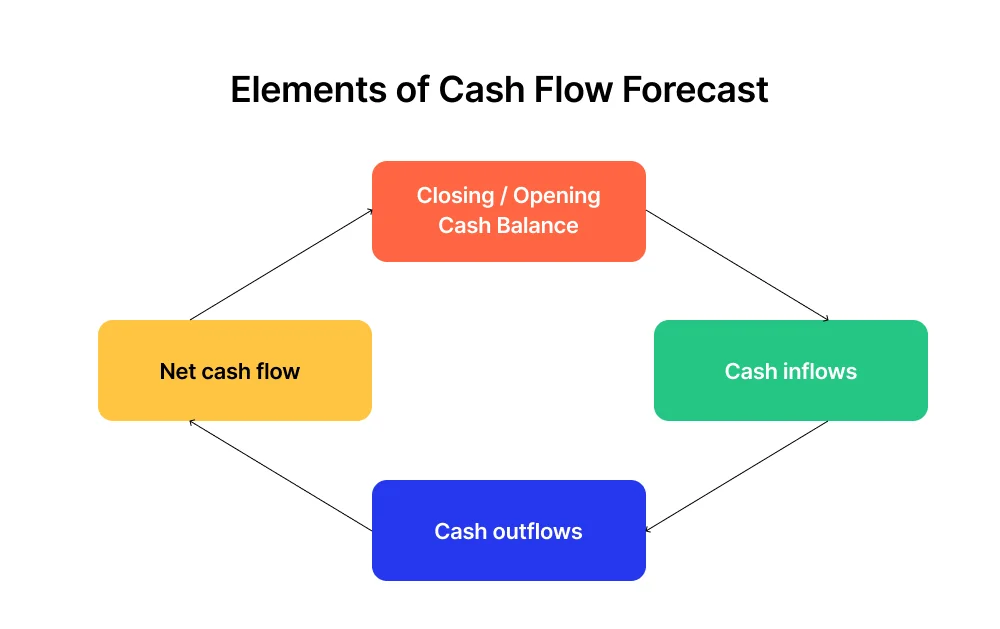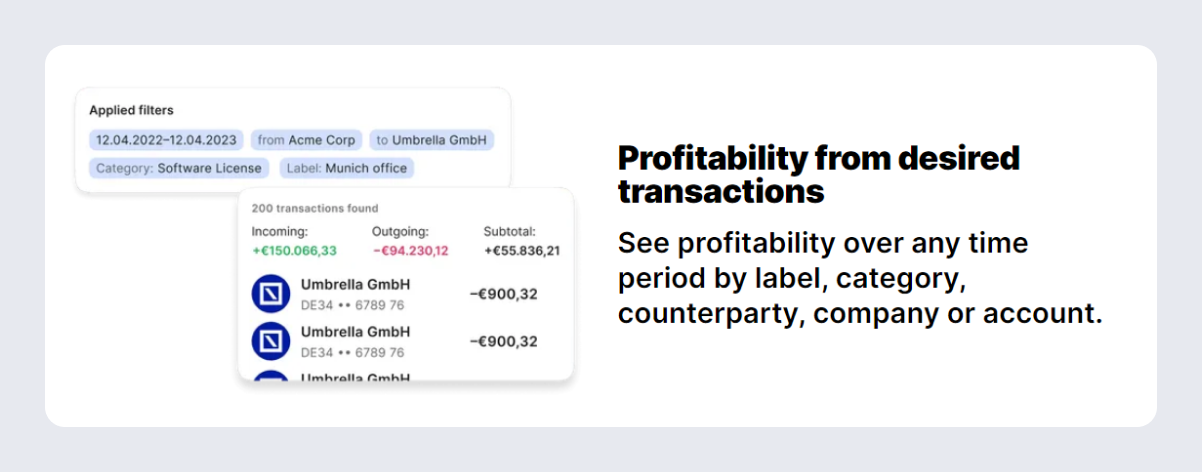Cash flow forecast is the backbone of any business’s financial health and liquidity management.
However, its role seems to be even greater for startups and small businesses because it gives them the opportunity to impress potential investors and raise the necessary capital.
With that in mind, let’s dive in and check other valuable benefits of cash flow forecasts.
What is a Cash Flow Forecast?
Cash flow forecasting predicts your business's future cash inflows and outflows over a specified period, typically on a monthly or quarterly basis.

Consequently, you can anticipate when you might experience cash shortages or surpluses and make informed decisions about managing your finances effectively.
Moreover, you can plan for potential expenses, investments, and loans, ensuring sufficient liquidity to cover operational costs and other financial obligations.
What Are The Elements of Cash Flow Forecast?
It is important to know what constitutes a cash flow forecast in order to understand the concept better.
✨ Starting or opening cash balance
It represents the amount of cash available at the beginning of the forecast period, and it can be positive or negative.
✨ Cash inflows
Refers to revenue and other sources of cash coming into the business, such as sales, investments, loans, etc.
✨ Cash outflows
Comprises expenses and other uses of cash leaving the business, such as salaries, rent, utilities, loan repayments, etc.

✨ Net cash flow
Represents the net change in the cash position, and you can calculate it by subtracting total cash outflows from cash inflows over the forecasting period.
✨ Closing cash balance
It is the positive or negative amount of cash you’ll have at the end of the forecast period, which you carry over to the new accounting period as your starting balance.
What Are 3 Main Purposes of Cash Flow Forecast?
Cash Flow Forecast provides multiple purposes, including:
- Managing liquidity — Predicting cash flow can ensure you have enough cash on hand to meet your financial obligations and avoid running out of money.
- Budgeting and planning — Helps you create realistic budgets and plan for future expenses and investments.
- Securing financing — Lenders and investors often require cash flow forecasts to assess a business's ability to repay loans or generate returns on investments.
Naturally, the key purposes of cash flow forecasting align with the key benefits it brings.
8 Top Benefits of Cash Flow Forecast
Once you get an idea of what your cash flow may look like in the near future, you can better prepare and plan your next moves.
1. Identifying Potential Cash Shortfalls
A cash flow forecast can highlight periods when you may experience a cash shortage, allowing you to take proactive measures to address the issue before it becomes a crisis.
One way to address cash shortfalls is to streamline your expenses.
If you closely monitor your budget and cut unnecessary costs, you can free up cash to cover any gaps in your cash flow.

Furthermore, you may also explore options such as:
- Renegotiating payment terms with suppliers or
- Seeking additional financing from lenders to boost your cash reserves during challenging times.
Puls’s Loan Feature enables you to get credit within 48 hours after connecting your bank account.
You can tailor the loan to your needs and set the desired amount and the loan period.

This way, you can bridge the financial gap and improve your cash reserves.
2. Planning Finances Better
Financial planning is closely related to the above one since predicting future cash inflows and outflows enables you to anticipate any cash shortages or surpluses and take action.
This way, you can gain valuable insights into your financial health and make informed decisions about how to manage your finances effectively.
With this in mind, you can better:
- Allocate resources,
- Prioritize expenses, and
- Identify opportunities for growth.
Furthermore, you can continuously assess your financial performance and make strategic adjustments by regularly updating and reviewing cash flow forecasts.
With Puls, you can categorize and label all your transactions and see the current and future ones from a single dashboard.

Thus, you can track balances and spending across different accounts and companies more efficiently.
3. Playing What-If Scenarios
"What if" scenarios provide a safe playing field to analyze the potential impacts of various hypothetical situations on your cash flow.
Thus, you can understand how different factors influence your financial position and make informed decisions to mitigate risks or capitalize on opportunities.
For example, you can simulate scenarios in which revenue fluctuates, such as a decrease in sales due to market conditions or an increase from new product launches.

Furthermore, scenario analysis can involve changes in operating expenses, such as unexpected cost increases or cost-saving measures.
Therefore, you can evaluate how different cost scenarios impact cash flow and identify areas for cost optimization.
Other examples of “what-if” scenarios include:
- Scenarios based on changes in market trends, such as shifts in demand, pricing strategies, or competitive pressures.
As a result, you can adapt strategies to stay competitive and maintain healthy cash reserves.
- Scenarios evaluating different financing options, such as securing a loan, issuing bonds, or raising capital through equity.
This way, you can determine the most cost-effective and sustainable funding sources.
- Scenarios assessing the potential impact of risks like economic downturns, supplier disruptions, or regulatory changes on cash flow.
This scenario type is highly relevant since it allows you to implement risk mitigation strategies to safeguard financial stability.
4. Keeping Track of Late Payers
Keeping a close eye on your cash flow forecast will help you identify trends or patterns impacting your bottom line.
For instance, you may notice a consistent shortfall in your forecast due to the clients who are constantly late in paying their invoices.
Thus, you can apply stricter payment terms, contact clients to follow up on outstanding invoices, or even consider cutting ties with clients who continually cause cash flow problems.
On the other hand, a detailed cash flow forecast will also provide you with a clear picture of what your financial situation would look like if everything went according to plan.
5. Keeping Track of Your Costs
Cash flow forecasting is essential to keep cash outflow in check and identify the areas where you may overspend.
If you set a projected monthly budget for expenses like utility bills, rent, and supplies, you can easily determine the expected total cash outflow and plan better.
If it weren’t for a cash flow forecast, it would be challenging to pinpoint errors in expenditure.
With Puls, you can input your regular monthly expenses once, and the system will automatically display them the following month for easier financial management.

6. Improving Strategic Decision-making
When you apply cash flow forecasts, you can make informed decisions about expanding, investing, or cutting costs depending on your projected cash flow.
Therefore, you can allocate your resources and decide whether to invest in new equipment, expand into new markets, or streamline operations to cut costs.
For example, if you anticipate a cash surplus in the coming months, you may invest in marketing initiatives to attract new customers and increase revenue.
Conversely, if you foresee a cash shortage, you may opt to delay certain expenses or negotiate better payment terms with suppliers.
7. Managing Debts
The cash flow forecast provides valuable insights to help you manage your debt obligations and plan for upcoming debt payments accurately.
Once you’ve incorporated debt repayment schedules into the forecast, you can ensure you have sufficient funds available to meet your debt obligations on time.
Furthermore, thanks to the cash flow forecast, you can:
✨ Assess Debt Capacity — Analyze the ability to generate cash flow to cover existing debt payments and additional debt service costs.
✨ Debt Refinancing Opportunities — Identify opportunities to refinance existing debt at more favorable terms, such as lower interest rates or extended repayment periods.
You can also analyze the impact of different refinancing scenarios on cash flow and make strategic decisions to optimize the debt structure.
✨ Debt Repayment Prioritization — Prioritize your debt repayments based on the debt terms, interest rates, and urgency of payment.
✨ Risk Mitigation — Anticipate potential cash flow challenges that may impact your ability to pay debt.
If you spot risks early, you can implement risk mitigation strategies, such as:
- Building cash reserves,
- Diversifying revenue streams, or
- Negotiating flexible debt repayment terms with lenders.
8. Managing Risks
Due to the cash flow forecast, you can identify, assess, and mitigate various risks impacting your cash flow and overall financial health.
The risks can span revenue fluctuations, cost overruns, market volatility, or external economic factors.
This is where the scenario analysis we’ve mentioned comes in handy. It allows you to model different risk scenarios to understand the potential outcomes for cash flow.
Furthermore, cash flow forecast enables you to develop contingency plans to manage unforeseen risks and uncertainties and minimize the financial impact of adverse events.
Therefore, you can implement risk mitigation strategies and safeguard cash flow stability against potential risks.

🎁 Bonus: 3 Steps to Create Effective Cash Flow Forecast
There are a few things to bear in mind when creating a cash flow forecast.
1. Define your objective
Although cash flow’s overall purpose is to help with liquidity management, you need to define objectives for your specific use.
Is it to monitor changing trends, get more info about debts and late payments, etc.?
2. Automate Data Gathering
Leveraging various FinTech options and accounting software can help you automate otherwise error-prone tasks and enable you to perform tasks faster and more accurately.
Puls Project FinTech solution lets you rely on accurate, real-time data for improved business decisions.
Thus, you can avoid manual errors and leverage data that we sync multiple times daily, keeping your financials up-to-date.
3. Monitor All Cash Flow Forecasts
Short-, middle-, and long-term projections all play an essential role in forecasting and complement and contribute to each other.
Thus, you should monitor and combine all of them for the most optimal results.

How Can You Leverage Puls Project to Improve Your Cash Flow?
Puls Project is an all-in-one FinTech solution that spans 3 major categories: multi-banking, loans, and cash flow planning.
Thus, it provides a comprehensive tool to streamline your financial operations while making you more attractive to potential investors.
With Puls Project, you can:
💰 Link any bank account from over 4,000 German banks and view and manage all companies and accounts in one place.
💰 Analyze profitability by label, category, counterparty, company, or account.

💰 Apply for up to €100,000 credit for a period of 12 months in 3 easy steps.

💰 View balances and transactions of all accounts in one glance.
💰 Manage invoice payments efficiently and maintain a clear history of payments.
💰 Schedule a future-dated draft payment to see how it will impact your business immediately.
💰 Increase your available credit line by regularly planning incomes and expenses via our platform so we can get to know your business better
💰 Manage your financial operations without needing to switch between different banking platforms.
💰 Monitor your cash flow actively, and if we detect a cash gap, we will highlight it so you can make necessary adjustments, such as transferring funds or considering a loan.
Keep Learning:
Limitations of Cash Flow Forecast - Challenges & Solutions





